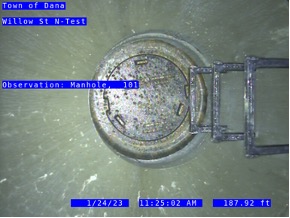Assessing Your Collection System with a Pipeline Camera System

Importance of Assessing Your System
In these times of tight budgets and extreme rain events, it makes good financial sense to stay on top of the condition of your wastewater collection system. Having a long-term maintenance and inspection plan in place will help extend the useful life of the system. If an issue is suspected, it is important to inspect as soon as possible; for many systems, spending money sooner to correct inflow and infiltration (I&I) issues will save on replacement and operating costs (e.g. wear & tear, chemicals, and electricity) down the road.
When to Inspect Your System
Inflow occurs when a sump pump or floor/tile drain discharges into the system, resulting in an increase of stormwater during rain events. Infiltration describes groundwater seeping into an aging pipe infrastructure through leak points and cracks. Both result in increased flows during and after rain events. Many utilities become aware of I&I when they experience spikes in flows at the plant after rain events, lift stations constantly running, gravity pipes surcharging, and/or manholes flooding.
Methods for Investigation
There are four primary methods for assessing the condition of your system: flow metering, smoke testing, dye testing, and video (CCTV). You may choose to use a combination of techniques. With the camera method, a small, closed-circuit camera is run down the pipes to visually inspect them.
If infiltration is identified, your utility will need a plan to address each component. Your plan may involve CCTV to complete a field investigation, and then replacing manhole covers, grouting/lining manholes, and/or lining/replacing pipe segments.
Tips for Pipeline Camera Inspections of Your System
There are normally two reasons to conduct a sewer inspection:
- To identify and fix a problem that you are having (e.g. line break/crack, blockage/backflow, emergencies).
- Routine maintenance, to avoid emergencies and problems down the road.
When using the pipeline camera inspections technique, it allows you to complete both simple and general projects. Simple projects can be done without any pre-configurations. This is a direct start approach, for just recording videos and taking screenshots of problematic areas in the line, in which you can overlay a free text of the problems found. General projects allow the same methods (screenshots and video recordings); however, they also allow for more detailed data, logs, and free-text overlay to be saved to generate more detailed reports.


Pictures by: Eleisha Shelton
To ensure that your inspection reports are accurate, operators should create a camera inspection checklist. A good checklist should include sectioning out your system (this will make it easier when recording and quicker to knock out), material composition used, problematic area, maintenance/cleaning, testing/inspections, pressure readings, and whatever best fits your system.
Funding Your I&I Strategy
- Plan ahead to save. When considering any capital improvement project, think about adding an I&I study or repairs to the project budget.
- Save money by performing line repairs when the ground is already being disturbed for other projects (road repairs, for example).
- Reach out to non-profit organizations such as RCAP, whose experts can provide free technical assistance. Additionally, your state’s RCAP Technical Assistance Provider can help your utility with applying for grants and low-interest loans, such as RCAP’s Revolving Loan Fund, USDA-Rural Development Water and Environmental Programs (WEP), State Revolving Loan Funds, and Community Development Block Grants.
Additional Resources
- Funding resources: https://www.rcap.org/obtaining-infrastructure-funding-resources/
- USEPA Quick Guide for Estimating I&I: https://www3.epa.gov/region1/sso/pdfs/QuickGuide4EstimatingInfiltrationInflow.pdf
- USDA Rural Development WEP:https://www.rd.usda.gov/programs-services/water-environmental-programs/water-waste-disposal-loan-grant-program

